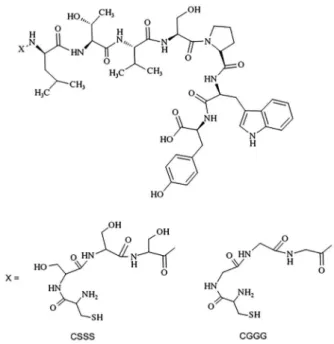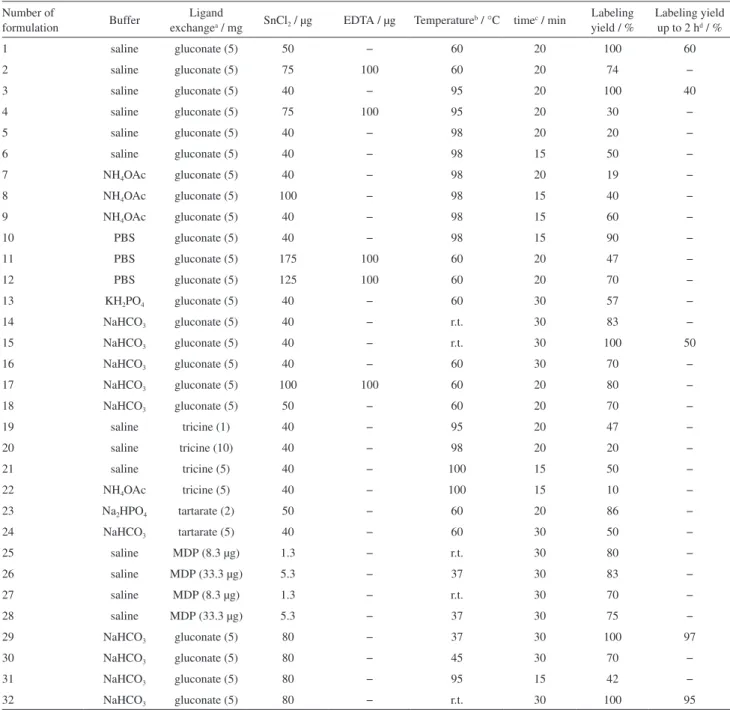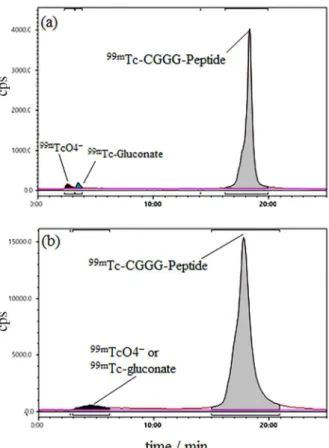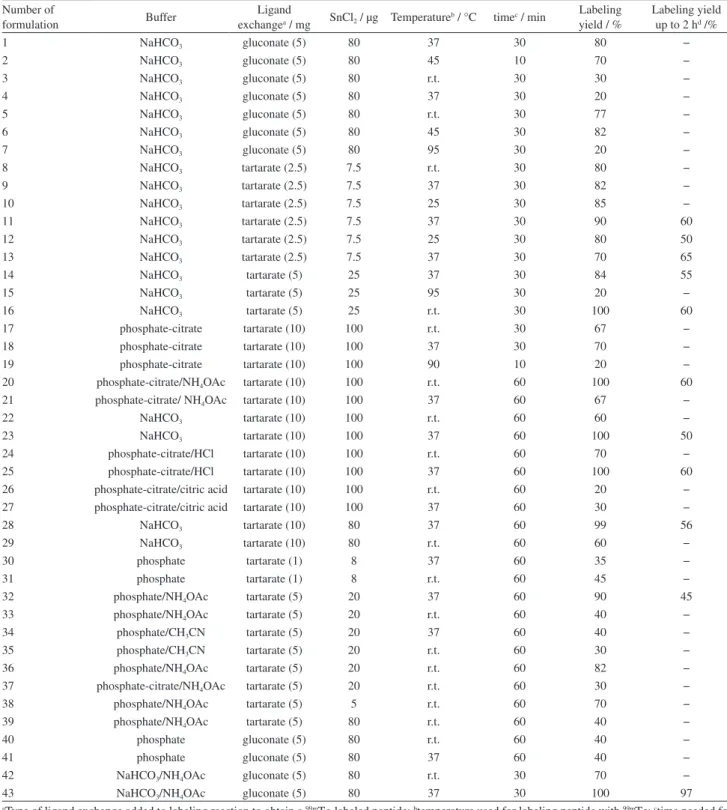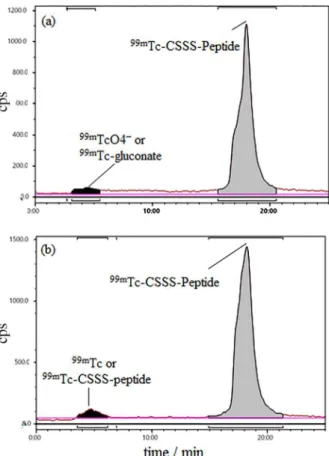Article
Printed in Brazil - ©2016 Sociedade Brasileira de Química0103 - 5053 $6.00+0.00
*e-mail: sjhosseinim@yahoo.com
Optimizing Labeling Conditions for Cysteine-Based Peptides with
99mTc
Hamideh Sabahnoo and Seyed Jalal Hosseinimehr*
Department of Radiopharmacy, Faculty of Pharmacy, Pharmaceutical Sciences Research Center, Mazandaran University of Medical Sciences, Sari, Iran
Radiolabelled peptides have attracted a great deal of attention due to their wide applicability in the development of target-specific radiopharmaceuticals. They can easily be used in diagnostic imaging as carriers for the delivery of radionuclides to tumors as well as for therapy. Previous investigations revealed that technetium(V) could form stable complexes with peptide-based ligands of N3S type such as Cys-Gly-Gly-Gly. Herein, a targeting HER-2 receptor peptide was labeled with
technetium-99m (99mTc) with two different types of tetrapeptide-based ligands, Cys-Gly-Gly-Gly
and Cys-Ser-Ser-Ser. The effect of experimental parameters in the labeling procedure such as type of buffer solutions, pH of media, and type of exchange ligands were optimized toward obtaining maximum labeling yield. The optimum labeling conditions were different for two peptides. Shelf life of both labeled peptides was determined by analytical reversed-phase high-performance liquid chromatography (RP-HPLC) and thin layer chromatography (TLC) that showed radiochemical yield up to 95% even after 4 h.
Keywords: optimizing labeling, cysteine based peptide, 99mTc
Introduction
Recent years have witnessed an increasing interest in radiolabelled peptides for nuclear medicine applications. This emergence is attributed to the overexpression of many receptors in numerous cancers compared to their relatively low density in normal organs.1 One of the most widely used
diagnostic radionuclides is technetium-99m (99mTc) due to
short half-life and optimum energy gamma emission. On the other hand, the existence of technetium in many oxidation states from, −1 to +7, offers an advantage for doing the necessary chemistry to prepare the various radiopharmaceuticals.2
Among these oxidation states, Tc5+ is widely used in
radiopharmaceutical formulations because of the stability of the resulting complexes TcO3+ oxotechnecium(V)
with quadridentate ligands such as N3S and N2S2.3,4
These complexes have a distorted square pyramidal structure with the oxo group perpendicular to the plane of the peptide nitrogen and sulfur coordinating atoms. It is noteworthy to mention that the presence of large S-donor atoms helps occupying the space around the metal ion more effectively compared to smaller N or O donor atoms.5,6
One of the design strategies for 99mTc-labeled
radiopharmaceuticals is bifunctional chelating agent
(BFCA) approach in which BFCA is used for 99mTc
chelating.7 An important property of BFCAs is the ability to
form complexes with high in vivo stability. The attachment of the BFCA-radiometal complex to peptide occurs through the following reactive groups: N-hydroxysuccinimide (NHS) esters, isothiocyanates or maleimide moieties.8
A wide variety of BFCAs and prosthetic groups such as mercaptoacetyltri-glycine (MAG3), diaminedithiol (DADT), 2-hydrazinonicotinic acid (HYNIC) and peptide based BFCA have been developed in recent years, allowing rapid and convenient radiolabeling of peptides with 99mTc.9
Among these various approaches, peptide labeling can be performed through peptide-based ligands via one-pot procedure and there is no need for a separate BFCA connection step. In other words, chelators consisting of amino acids may be added to small peptides during their solid phase synthesis. Targeting peptide containing tripeptide sequence Cys-Gly-Gly as N3S and Cys-Gly-Cys
as N2S2 groups can be chelated with 99mTc.10
These tripeptide chelating sequences usually form stable technetium complexes with the [TcO]3+ core.
Coordination of the radiometal to a linear peptide increases the receptor binding affinity to its intended receptor by creating a constrained macrocyclic metallopeptide with less conformational freedom.11,12 The site-specific metal
radiolabeled peptide.13,14 Moreover, peptide-based ligands
can simplify the chemistry of adding the metal binding sites. The aim of this study was to use the peptide sequences of cysteine-triserine (CSSS) and cysteine-triglycine (CGGG) that would enable labeling of LTVSPWY peptide with 99mTc (Figure 1). Shadidi and Sioud15 have identified
a 7-mer peptide, referred to as LTVSPWY that exhibited preferential binding and internalization into breast cancer cell lines by HER-2 receptors.
Experimental
Materials and instruments
CGGGLTVSPWY and CSSSLTVSPWY peptides were synthesized and purchased from ProteoGenix (Schiltigheim, France). The 99mTcO
4Na was eluted
from a 99Mo/99mTc radionuclide generator (Parsisotope,
Tehran, Iran). Acetonitrile (HPLC grade), sodium tartrate, sodium bicarbonate, phosphate, ammonium acetate, and ethylenediaminetetraacetic acid (EDTA) were obtained from Merck company (Darmstadt, Germany); trifluoroacetic acid (TFA), tin(II)-chloride dehydrate, gluconic acid sodium salt and tricine were from Sigma-Aldrich company (St. Louis, MO, USA). Solutions were prepared by standard procedures and using high-quality water. The distribution of radioactivity on the instant thin layer chromatography (ITLC) strips was quantified using a Lablogic mini scan TLC scanner (Sheffield, UK) and analyzed with Lura image analysis software. Radioactivity in the samples
was measured using a gamma counter with a NaI (Tl) detector gamma detector (Delshid, Tehran, Iran). Analytical reversed-phase high-performance liquid chromatography (RP-HPLC) was performed on a Knauer HPLC system (Berlin, Germany). The HPLC analyses of radiolabelled peptides were performed on Lablogic radioactivity gamma detector (Sheffield, UK). Column: Eurospher 100-5 C18, 4.6 × 250 mm (Knauer, Berlin, Germany) with pre-column; the mobile phase consisted of (A) 0.1% TFA in acetonitrile and (B) H2O. RP-HPLC elution was performed with a
solvent system consisting of: 0.1% TFA in acetonitrile (solvent A) and 0.1% TFA in water (solvent B). A gradient with solvents A and B was run as follows: 0 min, 10% A; 0-10 min, 10-30% A; 10-20 min, 30-80% A; 20-25 min, 80-10% A for a total time of 25 min. Flow rate: 1.0 mL min−1; all solvents were filtered and degassed earlier
entering the column.
Radiolabeling methods for two peptides
Two different approaches were used for radiolabeling of these peptides. The ligand exchange method, that was used gluconate, tartarate, tricine and methylene diphosphonate (MDP) ligands and different types of buffer solutions such as bicarbonate, ammonium acetate, phosphate and phosphate-citrate. In direct labeling method, different buffers such as phosphate buffer saline (PBS, pH 7.4), NH4OAc (pH 5.5) and NaOH (pH 12) were used at different
temperatures (60, 90 ºC and room temperature, r.t.) and amounts of SnCl2 (20, 40 and 100 µg). Various labeling
conditions were used for obtaining high radiochemical yield and shelf life for 99mTc-labeledpeptide (Table 1).
Radiolabeling of [99mTc(V)O] Cys-Gly-Gly-Gly-LTVSPWY
For this peptide, the optimum labeling yield was accomplished from 99mTc(V)O gluconate precursor. For this
purpose, 5 mg of sodium gluconate (C6H11NaO7) and 10 mg
of sodium bicarbonate (NaHCO3) were dissolved in 100 µL
of deionized water separately. To this mixture, 40 µL SnCl2
(2 mg mL−1, dissolved in 0.1 mol L−1 HCl) was added and
followed by a sodium pertechnetate (Na99mTcO
4) containing
300-400 MBq of 99mTc. The final volume of mixture was
reached to 1 mL by normal saline. The reaction was accomplished at room temperature for 10 min. An aliquot of 200 µL of the above solution (2-3 mCi) was added to 120 µL of an aqueous solution (pH 1-2) containing 10 µg peptide. The radiolabeled mixture was incubated at 37 oC
for 30 min. Then the radiochemical yield was determined by ITLC in different mobile phases such as PBS and mixture of pyridine/acetic acid/water and RP-HPLC. In ITLC, when PBS was used as mobile phase, free 99mTcO
4− and
99mTc-gluconate migrate with the solvent front (Rf = 1.0),
while peptide-bound 99mTc and colloid remain at the
application point (Rf = 0.0). However, for pyridine/acetic acid/H2O system the colloids (Rf = 0.0-0.3) remain at
the application point (Rf = 1.0) and peptide-bound 99mTc,
free 99mTcO
4− and 99mTc-gluconate migrate move with the
solvent front. In HPLC analysis, retention times of free
99mTcO
4− and 99mTc-gluconate were less than 5 min while
for 99mTc-labeled peptide was between 18-20 min.
Radiolabelling of [99mTc(V)O] Cys-Ser-Ser-Ser-LTVSPWY
For CSSSLTVSPWY, the optimum labeling reaction conditions was the same as CGGGLTVSPWY except for the amount of sodium bicarbonate, which was 25 mg and the activity of sodium pertechnetate was 100-200 MBq. Also, the peptide was dissolved in 100 µL ammonium acetate and the final volume of the mixture did not reach 1 mL.
Results
In direct labeling method, buffer solutions including PBS (pH 7.4), NH4OAc (pH 5.5) and NaOH (pH 12) were used.
The amounts of SnCl2 used were 20 to 40 µg. The reactions
were accomplished at 90 oC and r.t. for 30 and 60 min. The
obtained radiochemical yield in NH4OAc buffer was better
than other buffers. In order to confirm the good shelf life (efficacy of labeled compounds in over a period of time) of radiolabeled complexes with no considerable release of 99mTcO
4−, we checked shelf life up to 2 h by incubation
of reaction mixture at r.t. However, the shelf life after 2 h was unacceptable; radiochemical yield was less than 86% (Supplementary Information, Table S1).
As a result, we switched to ligand exchange method in which different ligands were used such as sodium gluconate, tartrate, tricine, and MDP. In the case of gluconate
ligand, different amounts of SnCl2 (40 to 150 µg) was
added to constant quantity of gluconate (5 mg) and was dissolved in PBS, ammonium acetate and normal saline (Table 2, No. 1-12). Since stable 99mTc(V)O-gluconate
complexes form in alkaline pH,16 we decided to change
the buffer solutions from PBS to alkaline buffers such as phosphonates or bicarbonate. All of the reactions were performed in one step, which means that the conditions of labeling for gluconate and peptide with 99mTc were the
same (Table 2, No. 13-18). It was observed a short-term radiochemical shelf life. Although the radiochemical yield of 99mTc-peptide was more than 90% even after 1 h, 99mTc-peptide complex was unstable up to 4 h. Thus other
exchange ligands such as tartrate, tricine and MDP were used . The competing reaction for tricine and tartrate with peptide in labeling with 99mTc started at the beginning of
the reaction while for gluconate displayed after 1 or 2 h. This result indicates that at the same conditions, tricine and tartrate desire to react with 99mTc in the presence of complex 99mTc-peptide more than gluconate. Moreover, changing
the amounts of SnCl2 and Na99mTcO4− were ineffective in
the formation of 99mTc-tartarate, 99mTc-tricine and TcO 4−
(Table 2, No. 19-24). By using MDP as a weak competing ligand,17 radiochemical purity was achieved at low yield
(Table 2, No. 25-28).
In the next strategy, sodium gluconate was dissolved it in bicarbonate buffer was used as ligand exchange. Labeling of gluconate in the presence of SnCl2 with 99mTc
was performed in 10 min. After performing various set of reactions, we figured out that to obtain an effective radiolabeling it is essential to change the pH of the peptide media and to create acidic conditions (pH = 1-2). Hence, the combination of two mixtures results the pH of the final solution to be around 6-7, which prevented relabeling of gluconate with 99mTc in the presence of peptide
(Table 2, No. 29-32).
Table 1. Summarized methods and conditions for labeling of two peptides cysteine-triserine (CSSS) and cysteine-triglycine (CGGG)-LTVSPWY
Method for labeling Buffer SnCl2 / µg Temperature / oC Ligand exchange
Direct PBS
NH4OAc
NaOH NaHCO3
20 to 100 r.t. to 90 −
Indirect PBS
NH4OAc
NaOH NaHCO3
NaH2PO4
saline NaH2PO4
-citrate
1.3 to 175 r.t. to 100 gluconate
MDP tartrate
tricine
Scanning of ITLC in order to detect radiolabeled peptide with a TLC scanner showed no 99mTCO
4−,
complexes 99mTc-gluconate (Supplementary Information,
Figure S1a) and no reduced hydrolyzed technetium colloids (RHT; Supplementary Information, Figure S1b). This result indicates the radiochemical yield of 100%.
After 1, 2 and 4 h, radiochemical yield were assessed by ITLC to be 97, 96 and 95%, respectively (Supplementary Information, Figure S2). In these conditions, RHT was
not observed. Moreover, the yield was also assayed by RP-HPLC at 1 and 4 h. The retention time of peptide was from 18 to 20 min and for mixture of 99mTCO
4− and 99mTc-gluconate complexes was 2-4 min. The obtained
radiochemical yield at 1 and 4 h was 97 and 95%, respectively (Figure 2). Resulting acceptable radiochemical yield due to single peak at 18-20 min retention time, showed a high specific activity (2-3 mCi per 10 µg or 8.42-12.64 GBq per µmol).
Table 2. Conditions for optimizing labeling of peptides cysteine-triglycine (CGGG)-LTVSPWY via ligand exchange Number of
formulation Buffer
Ligand
exchangea / mg SnCl2 / µg EDTA / µg Temperatureb / °C timec / min
Labeling yield / %
Labeling yield up to 2 hd / %
1 saline gluconate (5) 50 − 60 20 100 60
2 saline gluconate (5) 75 100 60 20 74 −
3 saline gluconate (5) 40 − 95 20 100 40
4 saline gluconate (5) 75 100 95 20 30 −
5 saline gluconate (5) 40 − 98 20 20 −
6 saline gluconate (5) 40 − 98 15 50 −
7 NH4OAc gluconate (5) 40 − 98 20 19 −
8 NH4OAc gluconate (5) 100 − 98 15 40 −
9 NH4OAc gluconate (5) 40 − 98 15 60 −
10 PBS gluconate (5) 40 − 98 15 90 −
11 PBS gluconate (5) 175 100 60 20 47 −
12 PBS gluconate (5) 125 100 60 20 70 −
13 KH2PO4 gluconate (5) 40 − 60 30 57 −
14 NaHCO3 gluconate (5) 40 − r.t. 30 83 −
15 NaHCO3 gluconate (5) 40 − r.t. 30 100 50
16 NaHCO3 gluconate (5) 40 − 60 30 70 −
17 NaHCO3 gluconate (5) 100 100 60 20 80 −
18 NaHCO3 gluconate (5) 50 − 60 20 70 −
19 saline tricine (1) 40 − 95 20 47 −
20 saline tricine (10) 40 − 98 20 20 −
21 saline tricine (5) 40 − 100 15 50 −
22 NH4OAc tricine (5) 40 − 100 15 10 −
23 Na2HPO4 tartarate (2) 50 − 60 20 86 −
24 NaHCO3 tartarate (5) 40 − 60 30 50 −
25 saline MDP (8.3 µg) 1.3 − r.t. 30 80 −
26 saline MDP (33.3 µg) 5.3 − 37 30 83 −
27 saline MDP (8.3 µg) 1.3 − r.t. 30 70 −
28 saline MDP (33.3 µg) 5.3 − 37 30 75 −
29 NaHCO3 gluconate (5) 80 − 37 30 100 97
30 NaHCO3 gluconate (5) 80 − 45 30 70 −
31 NaHCO3 gluconate (5) 80 − 95 15 42 −
32 NaHCO3 gluconate (5) 80 − r.t. 30 100 95
aType of ligand exchange added to labeling reaction to obtain a 99mTc-labeled peptide; btemperature used for labeling peptide with 99mTc; ctime needed for
labeling; dradiochemical yield 99mTc-labeled peptide assessed up to 2 h. EDTA: Ethylenediaminetetraacetic; NH
4OAc: ammonium acetate; PBS: phosphate
S a m e o p t i m i z e d l a b e l i n g c o n d i t i o n s f o r CGGGLTVSPWY were repeated for CSSSLTVSPWY but the radiochemical yield was unsatisfactory. In order to optimize the labeling condition, dominant experimental parameters such as the quantity of SnCl2 and the applied
temperatures were changed as shown in Table 3. However, an effective conjugation was not achieved (Table 3, No. 1-3). Since CSSS amino acids sequence is structurally different from CGGGLTVSPWY due to the presence of serine groups in its structure, we decided to eliminate acidic media of peptide (pH = 1-2) due to prevent from protonating OH groups to obtain better radiolabeling. For this purpose, this peptide was dissolved in ammonium acetate and acetonitrile (Table 3, No. 4-7). Also, ligand exchange was changed from gluconate to tartrate, and buffer was phosphate and phosphate-citrate (Table 3, No. 8-41). But unfortunately, it was unsuccessful for obtaining a long-term stability for radiolabeled peptide
Finally, for optimizing labeling condition, gluconate was used as ligand exchange while the amount of bicarbonate buffer was increased up to two times with the peptide dissolved in ammonium acetate (Table 3, No. 42-43).
The radiochemical yield was checked by ITLC and RP-HPLC like CGGG-peptide. Radiochemical yield was 99% at 30 min and 1 h, while it was reduced to 98 and 97% at 2 and 4 h after reaction, respectively. To prove the stable shelf life, results of RP-HPLC was also reported at 1 and 4 h. Radiochemical yield were 97 and 95% at 1 and 4 h, respectively (Figure 3). Resulting acceptable radiochemical yield due to single peak at 18-20 min retention time showed a high specific activity (3-4 mCi per 10 µg or 13.62-18.18 GBq per µmol).
Discussion
Biologically, active small peptides are favorable tools for diagnosis of various diseases because they offer many distinct advantages over proteins and monoclonal antibodies. Recently, a number of (99mTc)-labeled bioactive
peptides have discovered to be useful diagnostic imaging agents. N3S type ligand systems, such as Gly-Gly-Gly-Cys,
form stable complexes with185/187Re(V)/99mTc(V) due to
labeling peptide18 in high yield and specific activity through
the gluconate precursors.4,19
In the recent years, a series of studies involving labeling of affibody molecules with 99mTc using peptide-based N
3S
chelators has been reported. Substitution of the amino acids forming the chelator for binding 99mTc effected on
the biodistribution of affibody molecules.20-24
Our efforts were focused on radiolabeling of LTVSPWY peptide with 99mTc by two cycteine-based ligands of
Cys-Gly-Gly-Gly and Cys-Ser-Ser-Ser. 99mTc radiolabeling
of two peptides were accomplished through direct reduction and ligand exchange methods. In direct method, the use of reducing agents such as Sn (Π) can produce 99mTc
intermediates that form unstablecomplexes with peptides.25
In ligand exchange method, 99mTc-chelate intermediate
allowed to react to peptides under mild conditions to form final acceptable radiolabeled peptides.26 For optimizing
labeling, in direct method, the influence of pH (changing buffers from acidic to alkaline), concentration of SnCl2
and temperature was investigated on radiochemical yield. Although, in acidic conditions (using buffer NH4OAc),
maximum radiochemical yield was accepted but it was not stablefor 2 h after labeling.
In indirect method, the effect of types of ligand exchanges (gluconate, tartarate, tricine and MDP) , buffers (PBS, phosphate, phosphste-citrate, ammunium acetate and bicarbonate), pH, amount of SnCl2 and temperatures
was studied for accepting maximum labeling yield. The high long-term radiochemical stability was accomplished through gluconate and bicarbonate buffer in pH range of 6-7. In addition to bicarbonate buffer, other buffers like
Figure 2. Radio high-performance liquid chromatography (HPLC) analysis of 99mTc- cysteine-triglycine (CGGG)-LTVSPWY peptide shelf
life for 1 h (a); and 4 h (b) after labeling. The retention time of peptide was from 18 to 20 min and for mixture of 99mTCO
as normal saline, phosphate, phosphate-citrate, PBS for accepting pH rang 6-7 was tested but radiochemical yield was unsuccessfull (less than 95%). In vitro stabilities of two peptides were assessed by ITLC and RP-HPLC. Results
obtained during the shelf life studies demonstrated that two ligands stabilized as to chemical decomposition. Both complexes of peptides with 99mTc were easily formed in
high radiochemical yield (> 95%) even after 4 h.
Table 3. Conditions for optimizing labeling of peptides cysteine-triserine (CSSS)-LTVSPWY via ligand exchange Number of
formulation Buffer
Ligand
exchangea / mg SnCl2 / µg Temperatureb / °C timec / min
Labeling yield / %
Labeling yield up to 2 hd /%
1 NaHCO3 gluconate (5) 80 37 30 80 −
2 NaHCO3 gluconate (5) 80 45 10 70 −
3 NaHCO3 gluconate (5) 80 r.t. 30 30 −
4 NaHCO3 gluconate (5) 80 37 30 20 −
5 NaHCO3 gluconate (5) 80 r.t. 30 77 −
6 NaHCO3 gluconate (5) 80 45 30 82 −
7 NaHCO3 gluconate (5) 80 95 30 20 −
8 NaHCO3 tartarate (2.5) 7.5 r.t. 30 80 −
9 NaHCO3 tartarate (2.5) 7.5 37 30 82 −
10 NaHCO3 tartarate (2.5) 7.5 25 30 85 −
11 NaHCO3 tartarate (2.5) 7.5 37 30 90 60
12 NaHCO3 tartarate (2.5) 7.5 25 30 80 50
13 NaHCO3 tartarate (2.5) 7.5 37 30 70 65
14 NaHCO3 tartarate (5) 25 37 30 84 55
15 NaHCO3 tartarate (5) 25 95 30 20 −
16 NaHCO3 tartarate (5) 25 r.t. 30 100 60
17 phosphate-citrate tartarate (10) 100 r.t. 30 67 −
18 phosphate-citrate tartarate (10) 100 37 30 70 −
19 phosphate-citrate tartarate (10) 100 90 10 20 −
20 phosphate-citrate/NH4OAc tartarate (10) 100 r.t. 60 100 60
21 phosphate-citrate/ NH4OAc tartarate (10) 100 37 60 67 −
22 NaHCO3 tartarate (10) 100 r.t. 60 60 −
23 NaHCO3 tartarate (10) 100 37 60 100 50
24 phosphate-citrate/HCl tartarate (10) 100 r.t. 60 70 −
25 phosphate-citrate/HCl tartarate (10) 100 37 60 100 60
26 phosphate-citrate/citric acid tartarate (10) 100 r.t. 60 20 −
27 phosphate-citrate/citric acid tartarate (10) 100 37 60 30 −
28 NaHCO3 tartarate (10) 80 37 60 99 56
29 NaHCO3 tartarate (10) 80 r.t. 60 60 −
30 phosphate tartarate (1) 8 37 60 35 −
31 phosphate tartarate (1) 8 r.t. 60 45 −
32 phosphate/NH4OAc tartarate (5) 20 37 60 90 45
33 phosphate/NH4OAc tartarate (5) 20 r.t. 60 40 −
34 phosphate/CH3CN tartarate (5) 20 37 60 40 −
35 phosphate/CH3CN tartarate (5) 20 r.t. 60 30 −
36 phosphate/NH4OAc tartarate (5) 20 r.t. 60 82 −
37 phosphate-citrate/NH4OAc tartarate (5) 20 r.t. 60 30 −
38 phosphate/NH4OAc tartarate (5) 5 r.t. 60 70 −
39 phosphate/NH4OAc tartarate (5) 80 r.t. 60 40 −
40 phosphate gluconate (5) 80 r.t. 60 40 −
41 phosphate gluconate (5) 80 37 60 40 −
42 NaHCO3/NH4OAc gluconate (5) 80 r.t. 30 70 −
43 NaHCO3/NH4OAc gluconate (5) 80 37 30 100 97
aType of ligand exchange added to labeling reaction to obtain a 99mTc-labeled peptide; btemperature used for labeling peptide with 99mTc; ctime needed for
labeling; dradiochemical yield 99mTc-labeled peptide assessed up to 2 h. EDTA: Ethylenediaminetetraacetic; NH
4OAc: ammonium acetate; PBS: phosphate
Conclusions
Radiolabeling of LTVSPWY peptide with 99mTc using
peptide-based chelators and gluconate as a ligand exchange was performed through ligand exchange and direct reduction method. Optimized labeling for peptides was obtained through ligand exchange method. The obtained results during the shelf life studies demonstrated that two ligands stabilized 99mTc using two tetra peptides chelators
of CGGG and CSSS. The radiolabeled peptide showed reasonable shelf life and high radiochemical yield (> 95%) in solution.
Supplementary Information
Supplementary data are available free of charge at http://jbcs.sbq.org.br as PDF file.
Acknowledgments
This work was supported financially by the Iran National Science Foundation (INSF), grant NO. 92024622.
References
1. Reubi, J. C.; Endocr. Rev. 2003, 24, 389.
2. Liu, G.; Hnatowich, D. J.; Adv. Anticancer Agents Med. Chem.
2007, 7, 367.
3. Blok, D.; Feitsma, H. I.; Kooy, Y. M.; Welling, M. M.; Ossendorp, F.; Vermeij, P.; Drijfhout, J. W.; Nucl. Med. Biol.
2004, 31, 815.
4. Francesconi, L. C.; Zheng, Y.; Bartis, J.; Blumenstein, M.; Costello, C.; de Rosch, M. A.; Inorg. Chem. 2004, 43, 2867.
5. Fani, M.; Maecke, H. R.; Okarvi, S. M.; Theranostics 2012, 2, 481.
6. Wong, E.; Fauconnier, T.; Bennett, S.; Valliant, J.; Nguyen, T.; Lau, F.; Lu, L. F.; Pollak, A.; Bell, R. A.; Thornback, J. R.; Inorg. Chem. 1997, 36, 5799.
7. Liu, S.; Chem. Soc. Rev. 2004, 33, 445.
8. Mease, R. C.; Lambert, C.; Semin. Nucl. Med. 2001, 31, 278.
9. Arano, Y.; Uezono, T.; Akizawa, H.; Ono, M.; Wakisaka, K.; Nakayama, M.; Sakahara, H.; Konishi, J.; Yokoyama, A.; J. Med. Chem. 1996, 39, 3451.
10. Liu, S.; Adv. Drug Delivery Rev. 2008, 60, 1347.
11. Giblin, M. F.; Jurisson, S. S.; Quinn, T. P.; Bioconjugate Chem.
1997, 8, 347.
12. Miao, Y.; Quinn, T. P.; Front. Biosci., Landmark Ed. 2007, 12, 4514.
13. Guo, H.; Shenoy, N.; Gershman, B. M.; Yang, J.; Sklar, L. A.; Miao, Y.; Nucl. Med. Biol. 2009, 36, 267.
14. Miao, Y.; Gallazzi, F.; Guo, H.; Quinn, T. P.; Bioconjugate Chem. 2008, 19, 539.
15. Shadidi, M.; Sioud, M.; FASEB J. 2003, 17, 256. 16. Russell, C. D. M.; Nucl. Med. 1980, 21, 1086.
17. Gourni, E.; Paravatou, M.; Bouziotis, P.; Zikos, C.; Fani, M.; Xanthopoulos, S.; Archimandritis, S. C.; Livaniou, E.; Varvarigou, A. D.; Anticancer Res. 2006, 26, 435.
18. Ahlgren, S.; Andersson, K.; Tolmachev, V.; Nucl. Med. Biol.
2010, 37, 539.
19. Cyr, J. E.; Pearson, D. A.; Wilson, D. M.; Nelson, C. A.; Guaraldi, M.; Azure, M. T.; Lister-James, J.; Dinkelborg, L. M.; Dean, R. T.; J. Med. Chem. 2007, 50, 1354.
20. Altai, M.; Wallberg, H.; Orlova, A.; Rosestedt, M.; Hosseinimehr, S. J.; Tolmachev, V.; Stahl, S.; Amino Acids 2012, 42, 1975. 21. Bolzati, C.; Carta, D.; Salvarese, N.; Refosco, F.; Adv.
Anticancer Agents Med. Chem. 2012, 12, 428.
22. Engfeldt, T.; Tran, T.; Orlova, A.; Widstrom, C.; Feldwisch, J.; Abrahmsen, L.; Wennborg, A.; Karlstrom, A. E.; Tolmachev, V.; Eur. J. Nucl. Med. Mol. Imaging 2007, 34, 1843.
23. Tran, T. A.; Ekblad, T.; Orlova, A.; Sandstrom, M.; Feldwisch, J.; Wennborg, A.; Abrahmsen, L.; Tolmachev, V.; Karlstrom, A. E.; Bioconjugate Chem. 2008, 19, 2568.
Figure 3. Radio high-performance liquid chromatography (HPLC) analysis of 99mTc- cysteine-triserine (CSSS)-LTVSPWY peptide shelf
life for 1 h (a); and 4 h (b) after labeling. The retention time of peptide was from 18 to 20 min and for mixture of 99mTCO
24. Wallberg, H.; Orlova, A.; Altai, M.; Hosseinimehr, S. J.; Widstrom, C.; Malmberg, J.; Stahl, S.; Tolmachev, V.; J. Nucl. Med. 2011, 52, 461.
25. Ramos-Suzarte, M.; Pintado, A. P.; Mesa, N. R.; Oliva, J. P.; Iznaga-Escobar, N.; Aroche, L. T.; Pimentel, G.; Gonzalez, J.;
Cordero, M.; Rodriguezi, O. T.; Crombet, R. T.; Perez, R. R.; Cancer Biol. Ther. 2007, 6, 22.
26. de Kieviet, W.; J. Nucl. Med. 1981, 22, 703.
Submitted: September 24, 2015
